Top Ten Ways to Help Pollinators
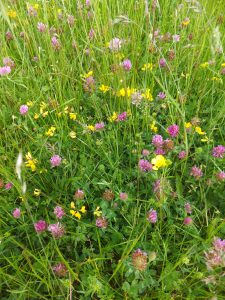
We’re often asked about the best ways to help our declining wild pollinators. Here are the All-Ireland Pollinator Plan’s top ten evidence-based actions you can take to help these important insects.
If you’d prefer, you can watch our Top Ten Actions for Pollinators video, which takes you through each of the recommendations.
You’ll also find links to information about how you can help pollinators every month, what plants they visit and which species you might spot. We’ll be adding a new page every month between February and October 2024.
1. Don’t mow, let it grow!
Reduce mowing to allow native wildflowers like Dandelions, Clover and Birds-foot Trefoil to naturally return over time.
Why? This action helps to restore species-rich grasslands: a vital habitat providing food and shelter for pollinators. Species-rich grasslands have been decimated in Ireland in recent decades. By reducing mowing – even to once a month – you will help them to slowly return, one pocket at a time
Where? Everywhere! Roadside verges, lawns, schools, parks, field margins, farm lanes. Even tiny biodiversity meadows or margins are valuable.
Idea: Take part in #NoMowMay and leave your lawnmower in the shed for May.
Find out more:
- Pollinator-friendly Grass Cutting
- How-to guide: Creating and restoring meadows in local communities and gardens
- Video: Top Tips for Creating a Wildflower Meadow
- Video: Creating Meadows for Biodiversity
2. Manage native hedgerows for biodiversity
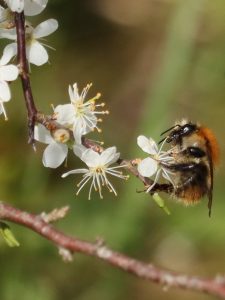
The more blossom your hedgerow has in spring, the better it is for biodiversity. Allow hedges to grow into a natural A-shape profile rather than a neat box shape. Flowers grow on older wood, so avoid cutting annually – cut on a three-year rotation instead to allow them to flower in spring.
Why: Native hedgerow plants such as Hawthorn (also called Whitethorn), and Blackthorn flower early in spring, providing vital food for wild bees when they emerge from hibernation. Birds and mammals eat their berries later in autumn. Hedgerows are an important nesting habitat for many creatures, forming vital corridors for nature through our more sterile modern landscape.
Where: Farms, parks, business parks, campuses, large schools, or gardens.
Idea: Pick blackberries within hedgerows in the autumn for natural, tasty treats – but make sure you leave plenty for the birds.
Find out more:
- How-to-guide: Hedgerows for Pollinators
- How to Plant a Hedgerow for Biodiversity
- Video: Managing Healthy Hedgerows
3. Plant pollinator friendly trees
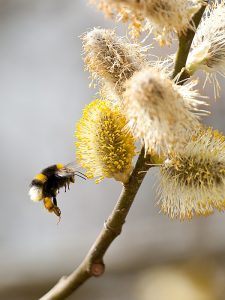
Native trees and shrubs such as Willow, Hawthorn, Rowan, Crab Apple, and Holly support huge numbers of insects including pollinators. Plant a young tree in the autumn or winter, or grow them from seed.
Why: Trees that blossom in spring are a low-maintenance, vital source of food for pollinators. Trees contribute to a healthy climate and biodiversity, supporting a rich variety of organisms such as lichens, mosses, birds, mammals, and insects.
Where: Anywhere there is space. Avoid areas that are already good habitats, or where you could create a biodiversity meadow or margin by reducing mowing.
Idea: Allow some mature trees to grow within hedgerows.
Find out more:
- Planting trees for pollinators flyer
- Orchards: perfect for pollinators flyer
- How to grow native trees from seed
4. Avoid using insecticides, fungicides and herbicides
These potent chemical cocktails are designed to kill various organisms. One of the best things you can do for pollinators is avoid using them. If you buy plants at a garden centre, ask if they have been treated with chemicals. Even ‘bee friendly’ labelled plants may have been treated with pesticides.
Why: Insecticides have been found to kill, harm, and disorientate pollinators. Herbicides kill the ‘weeds’ that provide them with important food.
Where: Everywhere!
Idea: Instead of using herbicides, enjoy spotting the little wildflowers that pop up when you stop spraying. You can follow our social media campaign on this #PlantsToCelebrate
Note: Herbicides should still be used to remove invasive species such as Japanese Knotweed.
5. Create nesting habitats for pollinators
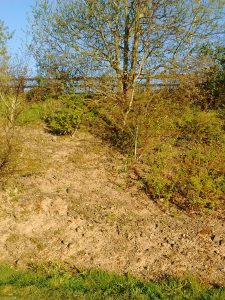
Wild pollinators nest in hedgerows, wild areas, dry stone walls, and even in the ground. To make a nesting habitat for them, just scrape back some bare earth, leave some areas to grow wild, or simply drill holes 10cm deep in unvarnished wood for solitary bees.
Why: Wild pollinators need safe nesting habitats for shelter and protection from predators in order to survive and thrive, and to allow next year’s pollinators to grow and develop.
Where: Choose areas that are close to flowers. Bumblebees need food within about one kilometre of their nests, and solitary bees will only travel a few hundred meters. You could also protect an old stone wall, a south facing earth bank, a hedgerow, or reduce mowing.
Idea: Create a small bee hotel out of reeds or bamboo stems. Hang it away from bird feeders at the start of spring and leave it alone for a year to see adult bees emerge the following spring.
Find out more:
6. Choose nectar and pollen-rich plants for your garden
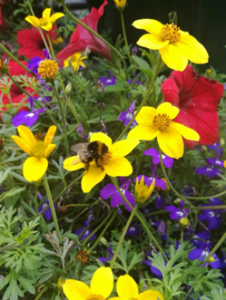
There are plenty of beautiful plants you can choose for your garden that are rich in nectar and pollen. Bidens and Bacopa are great bedding plants for small containers and hanging baskets; and herbs such as Thyme and Rosemary provide food for you as well as for pollinators. Make sure you keep these plants to your garden and don’t plant them in the wider landscape. Outside your garden, the best action for pollinators is to create biodiversity meadows and margins by reducing mowing.
Why: Pollinators need flowers that produce lots of nectar (for energy) and pollen (for protein).
Where: Gardens, pots on a balcony, window boxes, public parks, schools, and businesses. Avoid adding these plants to the wider landscape.
Idea: Plant bulbs such as Snowdrop, Crocus, and Grape Hyacinth in the autumn to provide early food for emerging pollinators the following spring. Or plant five fruit trees to create a mini orchard.
Find out more:
- Top Ten Pollinator-friendly Plants for Different Situations
- Pledge your Garden: How to make a Pollinator friendly garden
- Pollinator-friendly plants for your garden
- Pollinator-friendly herbs
7. Think twice about getting a hive of honeybees
On the island of Ireland, we have one honeybee species, and it is not in decline. Most honeybees are ‘domesticated pollinators’, living in hives and managed by beekeepers. Our 100+ wild bee species are under threat. If we have too many honeybee hives in the landscape, they can compete for food with our struggling wild pollinators. You should only get a honeybee hive if you want to start a new hobby, but it is not the best thing to do for biodiversity.
If you are thinking of getting a hive of honeybees, please get in touch with your local beekeeping association to learn how to keep healthy honeybees; avoid spreading disease to other hives and to our struggling wild pollinators.
Find out more:
- Blog: Too many honey bees can threaten wild bees
- Blog: Is there competition between domesticated bees and wild pollinators?
- Paper: Decline in wild bee species richness associated with honey bee abundance in an urban ecosystem
8. Be careful with wildflower seed mixes
You might be surprised to hear that sowing wildflower seed mixes can be detrimental to local biodiversity. Many wildflower seed mixes contain non-native species, and can inadvertently introduce invasive species. Please avoid using them where possible. If you do decide to sow wildflower seed mixes, keep to garden settings, ensure they are native and of Irish origin, and never use in situations where natural habitat restoration is possible (Don’t mow, let it grow). Alternatively, you could collect and sow seeds from local wildflowers.
Note: The All-Ireland Pollinator Plan does not endorse any wildflower seed mixes, despite what third party websites may imply.
Find out more:
- Why We Don’t Recommend Wildflower Seed Mixes
- Blog: Spreading Seeds of Doubt: Fake ‘wildflower’ mixes
- How-to Guide: Collecting and using pollinator friendly wildflower seed
9. Don’t install a large bee or insect hotel
Large bee hotels are attractive to humans, but not great for pollinators. They can encourage the spread of disease and attract predators. Avoid anything bigger than an average-sized bird box. There are many other ways to provide nesting habitats for pollinators, such as providing wild areas of undisturbed long grass, and scraping back some bare earth. If you want to make a bee hotel, make sure it is small, and position it away from bird feeders so the insects aren’t easy targets.
Find out more:
10. Spread the word
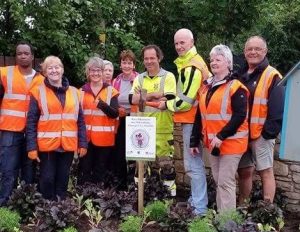
Many people want to help pollinators and biodiversity, but it can be hard to know where to start. Tell your friends and family about these top ten ways to help pollinators; join a community group or Tidy Towns; talk to your council, school, college, workplace, or faith community.
Change happens when word spreads. Even talking to just one person could lead to a change in how a crucial habitat is managed. If that person tells one person, and so-on, eventually we will have a network of habitats where pollinators can survive and thrive.
Find out more:
